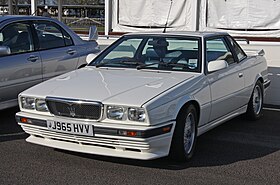Maserati Biturbo
| Maserati Biturbo | |
|---|---|
 |
|
| Overview | |
| Manufacturer | Maserati |
| Production | 1981–1994 |
| Assembly | Maserati, Modena, Italy Zagato, Terrazzano di Rho, Italy (Spyder) |
| Designer | Pierangelo Andreani Marcello Gandini (1988 and 1991 facelifts) Zagato (Spyder) |
| Body and chassis | |
| Class | Sports / Luxury / GT |
| Body style | 2-door 2+2 coupé 4-door 4-seat sedan 2-door 2-seat cabriolet |
| Layout | Front-engine, rear-wheel-drive |
| Powertrain | |
| Engine | 2.0 L twin-turbo 90° V6 petrol 2.5 L twin-turbo 90° V6 petrol 2.8 L twin-turbo 90° V6 petrol |
| Transmission | 5-speed ZF manual 3-speed automatic 4-speed ZF automatic |
| Dimensions | |
| Wheelbase | 2,514 mm (99.0 in) (coupé) 2,600 mm (102.4 in) (saloon) 2,400 mm (94.5 in) (Spyder) |
| Length | 415 cm (163.4 in) (coupé) 440 cm (173.2 in) (saloon) 404 cm (159.1 in) (Spyder) |
| Width | 171 cm (67.3 in) (coupé, Spyder) 173 cm (68.1 in) (saloon) |
| Height | 131 cm (51.6 in) (coupé, Spyder) 136 cm (53.5 in) (saloon) |
| Chronology | |
| Successor | Ghibli and Quattroporte IV |
| Maserati 228 | |
|---|---|
 |
|
| Overview | |
| Also called | Maserati 228i |
| Production | 1986–1992 |
| Designer | Pierangelo Andreani |
| Body and chassis | |
| Class | Grand tourer (S) |
| Body style | 2-door, 5-seat coupé |
| Powertrain | |
| Engine | 2.8 L twin-turbo V6 petrol |
| Transmission | 5-speed ZF manual 4-speed automatic |
| Dimensions | |
| Wheelbase | 2,600 mm (102.4 in) |
| Length | 4,460 mm (175.6 in) |
| Width | 1,865 mm (73.4 in) |
| Height | 1,330 mm (52.4 in) |
| Kerb weight | 1,240 kg (2,734 lb) (dry) |
| Chronology | |
| Predecessor | Maserati Kyalami |
| Successor | Maserati Ghibli |
| Maserati Karif | |
|---|---|
 |
|
| Overview | |
| Production | 1988–1993 |
The Maserati Biturbo was a family of luxury sports cars, saloons and grand tourers produced by Maserati between 1981 and 1994. The original Biturbo was a two-door, four-seater notchback coupé (of somewhat smaller dimensions than the BMW 3 Series of the time) featuring, as the name implies, a two-litre V6 engine with two turbochargers and a luxurious interior. The car was designed by Pierangelo Andreani, Chief of Centro Stile Maserati up to 1981, somewhat influenced by the design of the recent Quattroporte III (Italdesign Giugiaro).
All Maserati models introduced from the Biturbo's inception in 1981 until 1997 were based on the original Biturbo architecture. Among them the coupés as the 2.24v. and the Racing, saloons as the 420, 425 and 430, the convertible Spyder, the Karif, the 228, the later grand tourers like Shamal and Ghibli II, as well as the Maserati Barchetta which used an ultimate version of the biturbo V6 engine.
When Alejandro de Tomaso acquired Maserati in 1976, he had ambitious plans for the marque. His plan was to combine the prestige of the Maserati brand with a sports car that would be more affordable than the earlier high-priced models that had traditionally made up the Maserati range. In fact, Maserati ceased making supercars like the ones developed under Citroën ownership altogether, like the Bora and Khamsin.
...
Wikipedia
